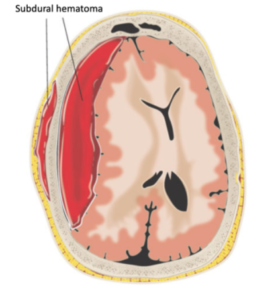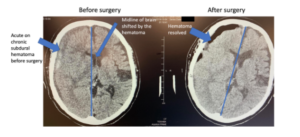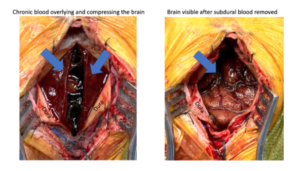
Common questions leading up to brain surgery revolve around postoperative care. “How much care will I require?” “Does someone need to be with me 24/7?” “Can I go upstairs?” What are my restrictions?” “How will I feel?” “When will I feel normal again?”
These common questions are highlighted by the recent death of Argentinian soccer star, Diego Maradona.
Most lay people have heard of Lionel Messi, likely one of the greatest soccer players of all time… an Argentine (Despite a 2019 poll, Brazil’s Pele likely is still the best). Both Maradona and Messi played for Argentina in the World Cup, and the Champion’s League’s Barcelona. Messi has more goals and overall accolades, however Maradona won the 1986 World Cup while Messi is still Cup-less. Overall, Diego was considered to be a take-charge leader of the Argentinian team, while Lionel may have just played “a part”. Maradona may be considered a bit of a “cheap” player, highlighted by his 1986 “Hand of God” goal. However his 2nd goal that game may have been one of the World Cup’s best, highlighting his duality in a single game on the pitch.
 Unfortunately post career, Diego suffered numerous problems with drug and alcohol addiction. In November 2020, he was hospitalized for low blood counts and dehydration, but a CT brain scan showed a subdural hematoma.
Unfortunately post career, Diego suffered numerous problems with drug and alcohol addiction. In November 2020, he was hospitalized for low blood counts and dehydration, but a CT brain scan showed a subdural hematoma.
A subdural hematoma occurs when blood builds up between layers covering the brain. Inside our skulls, we have about three layers of tissue overlying our noodle. Blood vessels leaving the brain drain into these tissues. With head trauma, these veins can rupture, leaking blood around the brain. This can compress our cerebrum leading to symptoms. Subdural hematoma refers to the blood (“hematoma”) residing under (“sub”) the covering (“dura”). As we age, our brain shrink, causing a stretch on these veins making their rupture easier. The peak age of onset of a chronic subdural hematoma is about 80-years- old. Alcohol or drug abuse could accelerate brain atrophy, making a chronologically younger brain appear decades older. Maradona’s neurosurgeon, Dr. Leopoldo Luque mentioned the 60-year old likely had an “accident”, although Diego didn’t remember the event. This is pretty common. The problem with subdural hematomas is that if the blood doesn’t resolve on its own fairly quickly (the body can reabsorb the blood like any other bruise in some cases), it can form a membrane and perpetually leak more blood. Surgery may be required. There is no clear guideline about the timing of surgery in a chronic subdural hematoma, although it is likely better to operate as soon as possible if a neurological problem develops to give the best change of good outcomes. Of course, in the setting of a large and acute (new) hematoma, surgery may be urgent or emergent.
 As Dr. Luque reported before Maradona’s surgery, subdural hematoma surgery is often “routine”. A favorable outcome can be seen in 70-90% of patients, however age is a crucial factor. Outcomes in patients older than 75 is significantly worse than those younger. We commonly would not expect a poor outcome in a 60-year-old like Maradona, however we do not know his risk factors or the details of his particular hematoma.
As Dr. Luque reported before Maradona’s surgery, subdural hematoma surgery is often “routine”. A favorable outcome can be seen in 70-90% of patients, however age is a crucial factor. Outcomes in patients older than 75 is significantly worse than those younger. We commonly would not expect a poor outcome in a 60-year-old like Maradona, however we do not know his risk factors or the details of his particular hematoma.
Based on reports, the November 3rd surgery went well and he left the hospital on November 11th. However on November 25th, Maradona was confirmed to have died, seemingly from cardiac induced fluid on his lungs. There is now debate if Maradona’s postoperative care was appropriate.
 Following brain surgery, there are patients, even older than 60 years old, that leave the hospital the day following surgery. Many healthy patients fare well. However other patients have a prolonged hospital course and some even need to be discharged to inpatient rehabilitation. Care is completely individualized. Based on reports, Maradona may have refused home health care, in which nurses or therapists come to the patient’s home.
Following brain surgery, there are patients, even older than 60 years old, that leave the hospital the day following surgery. Many healthy patients fare well. However other patients have a prolonged hospital course and some even need to be discharged to inpatient rehabilitation. Care is completely individualized. Based on reports, Maradona may have refused home health care, in which nurses or therapists come to the patient’s home.
Especially in these COVID-19 times, patients are fearful of going to rehab or nursing facilities, or even accepting home health care. Reportedly there are tens of thousands of patients contracting coronavirus at these facilities. According to Medicare data, discharges to rehab or nursing facilities has sharply declined in 2020. What is not clear is how COVID-19 has affected home health care. Patients may prefer being home where they feel safer, but these essential workers tend to travel between multiple high risk patient homes each day, increasing the risk of transmission to the most vulnerable. This is not to say that Maradona refused an inpatient post-hospital stay or home health care based on COVID-19, but it is plausible and many other patients like him already have.
Once a patient is discharged home from a craniotomy, we often encourage patients to be reasonably active at home to avoid blood clots in the legs (deep venous thrombosis/ DVT) or pneumonia. After surgery patients tend not be breathe as deeply, risking lung problems. Most patients are cleared by therapists to traverse stairs prior to hospital discharge, although they need to be cognizant of their balance. Rigorous activity, including regular exercise or lifting more than a gallon of milk, is usually avoided for about a month. Nothing that risks head trauma is avoided for longer. We recommend avoiding cooking over open flames. Patients usually are off work for 2-3 months. Driving is restricted for a few weeks, or even longer if a seizure has occurred. Most patients should have someone home with them, most of the time, for a few weeks, although they do not require constant 24/7 care. Many patients do not feel completely normal for 6-12 months. Headaches and overall lethargy are pretty normal for quite a while. Medications side effects like nausea or confusion can occur.
In summary, even in 2020, brain surgery requires a recovery period. Most younger patients undergoing a subdural hematoma evacuation do well, and it appears Maradona was an unfortunately rare case. We have lost a soccer legend. But even for patients without complications, it takes weeks to months to fully recover.






